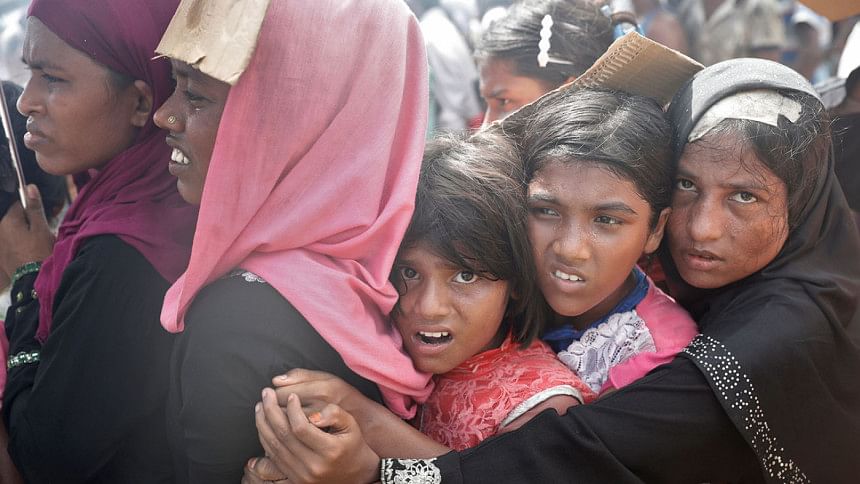Undocumented Rohingyas see 3.7-fold rise: Report

Some 607,735 undocumented Rohingyas have been identified in four upazilas of Cox's Bazar district and 53 percent of them are women and girls, says a new report.
The assessment was done in four upazilas of the district -- Cox's Bazar Sadar, Ramu, Teknaf and Ukhia.
This represents a 3.7-fold increase since the last reporting period in July, 2017 (164,000 displaced individuals), according to a report of the International Organization for Migration (IOM) a copy of which UNB received on Monday.
A total of 429,308 undocumented Rohingyas have arrived since August 25 due to the current ongoing outbreak of violence in the Rakhine State of Myanmar.
The majority of undocumented Rohingyas are living in Ukhia and Teknaf upazilas of Cox's Bazar district, a district bordering Myanmar identified as the main entry area for border crossing.
A total of 143 locations in 85 sites were assessed between September 5- 21, 2017.
A comprehensive registration system is still missing and therefore individual identification and information on the demographic breakdown is currently done through an extrapolation and estimation process, said the report.
The Needs and Population Monitoring (NPM) assessment provides an estimate at the site level.
An estimated seven per cent of undocumented Rohingyas are children under one year old, 29 per cent are children under five years old and four per cent are 60 years or older, according to preliminary findings of the report.
Ten per cent are pregnant or lactating women, said the report adding that 12 per cent of the undocumented Myanmar nationals households are headed by women, a situation that likely increases their vulnerability.
The NPM identified 1,480 unaccompanied and separated children, it said.
While there were around 113,735 undocumented Myanmar nationals in makeshift settlements in the beginning of August, that number has increased three-fold to 350,041 during the current reporting period.
Some 59,021 Rohingyas in Teknaf and 291,020 in Ukhia are living in makeshift settlements.
Out of 37 assessed locations in makeshift settlements, 14 per cent are katcha (temporary shelters made of materials such as mud brick, bamboo, sun-grass and wood) and 76 per cent are jhupri (shacks made of components such as jute sticks, tree leaves and jute sacks). Data was not yet collected for the remaining 10 per cent.
While there were 50,397 undocumented Rohingyas residing in host communities spread across two upazilas in the beginning of August, the NPM recorded the presence of 257,694 undocumented Rohingyas residing in host communities by 21 September across the four upazilas.
In 67 per cent of assessed host community locations, undocumented Rohingyas were living in katcha; 28 percent in Jhupri, and one per cent in semipucca (semi-permanent shelters where walls are made partially of bricks, floors are cemented and roofs of corrugated iron sheets).
Data was not yet collected in four per cent of locations.
The majority of undocumented Rohingyas at all assessed locations cite Rakhine state in Myanmar as origin.
Within Rakhine state, the majority populations of every assessed site reported originating from Maungdaw district.
One assessed location of approximately 2,000 undocumented Rohingyas, reported the township Buthidaung as place of origin while all other locations came from approximately 20 different villages of the township, Maungdaw within the district of the same name.
Maungdaw township is the westernmost town of Myanmar, right at the border with Bangladesh.
A narrow strait of 2-3km water separates the two countries. Buthidaung lies a few kilometres further inland.
Eighty-nine per cent of locations reported undocumented Rohingyas are buying food at local market.
Thirty-one per cent of locations acquired food through UN, INGO or NGO distributions and a further 21 per cent claimed to feed themselves by fishing.
The most common means of livelihoods was reported to be daily labour being the primary source of income at 57 percent of locations.
Fishing was reported to be the primary source of income at 25 per cent of locations.
The third most common answer was that there was no income at all.
Children at 89 per cent of locations could access a moktab or madarasa which were on site less than 30 minutes away at over half of all locations.
While 67 per cent of locations reported access to non-formal educational, this access was deemed to be limited for adolescent girls at 58 per cent of locations.
While the reasons were most of the time not clearly stated, many locations explained this barrier as being social norms (28 pc) a safety concern (18 pc).
Fifty per cent of locations additionally reported barriers to access education for boys, which were mainly due to the fact they these were engaged in other livelihood activities (34 pc of locations).
The National Strategy on Myanmar Refugees and Undocumented Myanmar Nationals (UMN) formulated by the government of Bangladesh highlighted the fact that the influx slowed in late February 2017.
However, new arrivals were reported in July 2017, and a massive influx started in late August 2017 as a result of further violence.

 For all latest news, follow The Daily Star's Google News channel.
For all latest news, follow The Daily Star's Google News channel. 



Comments